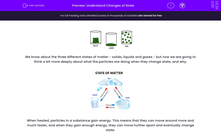
We know about the three different states of matter - solids, liquids and gases - but now we are going to think a bit more deeply about what the particles are doing when they change state, and why.
.jpg)
When heated, particles in a substance gain energy. This means that they can move around more and much faster, and when they gain enough energy, they can move further apart and eventually change state.
The opposite happens when a substance is cooled. The particles lose energy and become slower and closer together. You can see this in the diagram above - the particles in the gas are far apart and free to move independently of each other. As the gas cools to a liquid, the particles get closer together, and in a solid the particles are held together by strong forces of attraction. This is why particles in a solid can't move much, they can only vibrate on the spot.
There are some key terms we need to learn which explain these changes of state. When substances cool, they will either freeze or condense. When substances heat up, they may boil, evaporate, melt or sublime. Take a look at the diagram above to see what changes of state these words describe.
Does that all make sense?

Let's take a look at some questions on changes of state.








